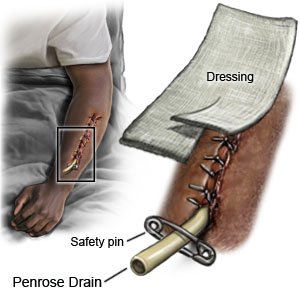Penrose Drain
Medically reviewed by Drugs.com. Last updated on Aug 4, 2025.
AMBULATORY CARE:
A Penrose drain
is a soft, flexible latex tube. The drain helps prevent infection by moving extra blood and fluids away from your surgery site. Part of the drain will be inside of your body. One or both ends of the drain will come out of a cut in your skin, called the drain site. There may be a safety pin at the end of the drain to keep the drain from going back into your body. The drain and surgery site will be covered with a dressing.
 |
How long your drain will stay in place
depends on:
- The type of surgery you had
- How much fluid is draining from your incision
- The reason for the drain
- The size of your incision
Seek care immediately if:
- The skin around your drain is red, swollen, or warm to the touch.
- The drainage from your drain site smells bad or looks different.
- You are bleeding from your drain site.
Call your doctor if:
- You develop a fever of 100.4 °F (38 °C) or higher.
- Your drain comes out.
- You have new or increased pain at your drain or incision site.
- You have questions or concerns about your condition or care.
Care for your drain:
Change your dressing at least 2 times each day. Change your dressing at the same times each day. Also, change your dressing if it gets wet or is loose.
- Gather supplies. You will need:
- Gauze dressings
- Soap and water
- A clean towel and washcloth
- Nonsterile gloves
- Tape
- A pair of scissors if the gauze does not already have a cut in it
- Wash your hands. Use soap and running water. Dry your hands with a clean towel or paper towel. You can also use an alcohol-based hand rub.

- Remove the dressing. Be careful to not pull on the drain. Write down how much drainage is on the dressing, what color it is, and how it smells. Also check the area for signs of infection such as pus, redness, and swelling.
- Wash your hands or use an alcohol-based gel again. Put on the gloves.
- Wash your surgery area. Use the washcloth, soap, and water to gently clean around and under the drain. Use the towel to gently pat the area dry.
- Put on a new, clean dressing. Place a gauze under the drain. The part of the drain with the pin should go through the cut in the gauze. The drain should lie flat on the gauze. If there is no cut in the gauze, use clean scissors to cut the gauze. Be careful not to cut the drain. Start in the middle of one side and cut to the middle of the gauze. Cover the drain with another gauze and tape it in place.
- Take off your gloves, throw them away, and wash your hands.
Follow up with your doctor as directed:
Write down your questions so you remember to ask them during your visits.
© Copyright Merative 2025 Information is for End User's use only and may not be sold, redistributed or otherwise used for commercial purposes.
The above information is an educational aid only. It is not intended as medical advice for individual conditions or treatments. Talk to your doctor, nurse or pharmacist before following any medical regimen to see if it is safe and effective for you.
Further information
Always consult your healthcare provider to ensure the information displayed on this page applies to your personal circumstances.
